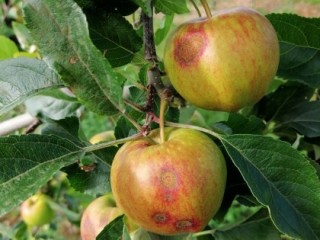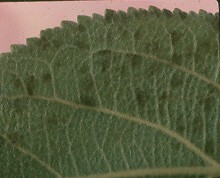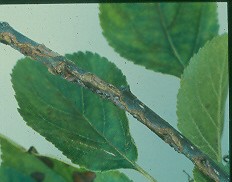
Apple scab infects most parts of the tree including leaves, petioles, blossoms, sepals, fruits, pedicels, shoots, bud scales. Symptoms are most easily observed on leaves and fruit.
Leaves

- As leaves first emerge in spring, the lower surface is first exposed and scab lesions therefore are first found on the leaf underside.
- Later when leaves unfold both surfaces are exposed and lesions appear on both sides.
- Young lesions are velvety brown to olive green with feathery indistinct margins which become more diffuse with age. Infected leaves may become distorted.
- Leaves with numerous scab lesions may shrivel and fall prematurely.
- Leaves are only susceptible when young, however, once the leaves become old and the cuticle cracks, they again become susceptible to scab.
- This usually occurs in late summer/autumn and the scab that develops is most visible on the underside as diffuse olive green almost black lesions (late scab).
- It is this scab that contributes to the overwintering stage.
Fruit
- The green tissue that first appears at bud burst later becomes the fruit sepals. Scab infection on these appears similar to that on leaves, eventually becoming shrivelled.
- Once the sepals are infected scab can readily infect fruit and scab lesions located around the fruit calyx usually indicate infection of the sepals at bud burst.
- Lesions on young fruit are similar to those on leaves, but as the fruit enlarge, the lesions become brown and corky.
- Early fruit infection can result in distorted, cracked fruits and premature fruit drop.
- Fruits are most susceptible to infection when young and susceptibility declines with age.
- Fruit infections that occur near harvest may not be immediately visible but develop in store as pin-prick or storage scab.
- These appear more as black, circular lesions ranging from 0.1‑4 mm diameter.
- They are very easy to see on varieties such as Bramley, Gala or Fiesta.
Wood scab and bud scale scab

- Wood scab and bud scale scab are similar and appear as raised blisters which eventually rupture exposing olive-green fungal growth.
- Usually only scab lesions on one-year-old wood produce viable conidia.
Other problems that may be confused with scab
- Scab lesions on leaves, wood and fruit are usually easily distinguished as scab.
- Wood scab may sometimes be confused with Nectria canker. Wood scab is usually more superficial and associated with olive-green fungal growth.
- Late scab on leaves may be confused with sooty mould growth. The latter can easily be scraped off.
